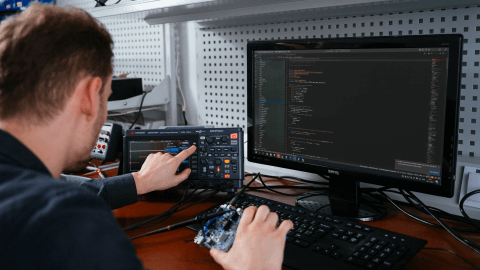RTOS, or real-time operating system, is a specialized set of software tools and algorithms for the embedded system. It is responsible for executing applications in real time within a predetermined time frame.
Our article outlines a comprehensive overview of various embedded RTOS platforms and the options they provide to simplify the selection process for your embedded project.
What is an RTOS, and why is it critical for embedded systems?
RTOS, or a real-time operating system, is a task-based operating system for embedded systems that ensures the operation of specific functions (tasks) within a predetermined time.
Before diving into RTOS's core features and capabilities, you can find what components the RTOS kernel consists of.

An embedded RTOS becomes an excellent choice for complex embedded systems that demand stable and uninterrupted operation thanks to efficient resource allocation and task prioritization. It is used for many applications in embedded systems with time restrictions.
The core component of RTOS for embedded systems is the scheduling algorithm, which determines how different system tasks are executed and in what priority.
There are two primary types of scheduling algorithms used in embedded software development:
- Preemptive - this type of RTOS scheduling ensures that engineers can assign task priorities (up to 31), where tasks with higher priority can interrupt the execution of lower-priority ones to ensure the critical tasks are processed.
- Non-preemptive - this type of RTOS scheduling ensures each task is executed from beginning to end when you know the priorities and execution time is predictable.
Various types of RTOS can be used in embedded systems where timing is crucial. Still, despite the RTOS type, it is used in a wide range of applications: in vehicle control systems, radio communications, medical devices, AI-based solutions, smart building control systems, and consumer electronics products.
What are the 4 main RTOS types?
Basically, there are four core types of real-time operating systems for embedded development, so let's look closely at them.

1. Hard real-time operating system
A hard real-time operating system is widely used for embedded solutions accountable for processing critical tasks and demanding precise time restrictions. It means that certain events must be executed in the predetermined moment, not a second earlier or later, as it will cause critical issues or even physical damage to the system.
2. Soft real-time operating system
A soft real-time operating system applies to embedded systems where missing the predefined time limits will not critically influence the related processes and overall system operation. It allows setting time deadlines to execute specific tasks, but missing these deadlines doesn't stop system operation.
3. Firm real-time operating system
A firm real-time operating system is a middle ground between hard and soft RTOS types, and here is how it works: with firm RTOS, system tasks may miss deadlines without consequences for the process and system operation.
Nevertheless, the number of tasks that can be missed is limited, as if they exceed the allowed quantity, it will cause critical system errors and delays.
4. Deterministic real-time operating system
A deterministic real-time operating system perfectly matches embedded systems where timing must be permanently precise. This type of real-time embedded programming allows for predicting the time needed to execute tasks of different priorities and complexity.
Deterministic scheduling will enable us to set up time frames for executing critical tasks accurately. It makes the embedded system operation predictable, stable, and reliable.
Advantages of RTOS in embedded systems
As you can see, the variety of real-time embedded system types eases selecting the right one for your embedded system. Now, let’s look deeper into the benefits of using RTOS for embedded systems and what results you can expect from these benefits.
Efficient application management
Real-time embedded systems development ensures the execution of a single application (process) within a restricted time. It means all critical tasks and results are achieved while other applications wait in a queue.
Availability
Real-time operating systems for embedded computing are compatible with various MCU platforms. It allows you to select RTOS and MCU types based on your goals without restrictions. Another option that makes RTOS available is round-the-clock operation and task performance that ensure the maximum embedded system output.
Fail-free nature
RTOS system, mainly if we speak about the hard type, ensures the embedded system and all tasks within it operate error-free. This is because the hard RTOS has strict time limitations, where all critical tasks are executed on time, keeping the system's work stable.
Code reusability
An RTOS-based system has reusable code to port to another platform and use in MCU, MPU, and FPGA. This feature helps save much engineering time and money, as there is no need to develop a system from scratch.
Debugging option
Debugging an RTOS-based application might be tricky and challenging, depending on the system's functionality and complexity. However, RTOS providers offer specifically-made debugging tools like Tracealyzer 39, SystemView, and others that make debugging more effective.

Disadvantages of RTOS in embedded systems
The following disadvantages of RTOS in embedded systems are not axioms but possibilities, depending on the RTOS type, system scalability, and the number of tasks. However, you should learn more about them to prevent or fix them in your embedded system on time.
A limited number of tasks
The limited number of tasks that can be performed simultaneously may become a challenge for embedded systems with multiple applications and functions. This option is caused by preventing potential operation errors, meaning the fewer tasks are executed, the lower the probability of missing timing and other errors.
Integration of interrupt signals
RTOS interrupts might pause the execution of specific tasks within the embedded system. It causes a strong need to follow these processes to ensure these interruptions don't delay the performance of other system tasks. Embedded engineers can also use critical section tools to forbid any task interruption to avoid a system dysfunction.
Reduced performance
A real-time operating system has a variety of tasks to manage within an embedded system. These are task scheduling, resource allocations, communication, etc. This overload can lead to low system performance, but this problem also depends on the RTOS scope and might not appear in smaller ones.
Nevertheless, when our embedded engineers start working on embedded system development, they calculate and predict all potential pros and cons of the selected RTOS for your project, considering its specifics. With our professional advice, some might be avoided, or have a refinement plan if some already exist in your embedded system.
7 popular RTOS platforms compared
We examined the most widely used embedded real-time operating systems and outlined their primary options, advantages, and applications.
1. FreeRTOS
FreeRTOS is considered the most popular real-time operating system in embedded system engineering. Its popularity is caused by low hardware requirements, compatibility with different MCU platforms, and easy-to-use APIs for timers and interrupts. FreeRTOS has two integrated scheduling algorithms - prioritized preemptive and time slicing, where tasks are executed after one another during a defined time frame.
Read also: FreeRTOS vs. Zephyr Project for Embedded IoT Projects
2. AUTOSAR/OSEK
Although Autosar is not an RTOS, it is widely used in embedded automotive system development. AUTOSAR, or AUTomotive Open System ARchitecture, is a good fit for embedded software designed for vehicles. Its initial purpose was to provide a standardized software programming platform for automotive electronic control units like powertrains, engines, ABS control, etc. The main peculiarity of Autosar lies in its compliance with the highest functional safety standard, ISO 26262, and its focus on timing, where OSEK handles the expected time frames.
3. Integrity
Integrity RTOS has been used for embedded software development for years due to its comprehensive functionality and compatibility. It is commonly used for embedded systems in military, aerospace, and other domains where safety, security, and high performance are critical.
The Integrity RTOS kernel is designed to protect the embedded system against both application errors and malicious code. Every application operates within its isolated virtual memory block, minimizing the risk of external tampering and potential conflicts with other system components.
4. SafeRTOS
SafeRTOS is a FreeRTOS derivative where safety is prioritized, ensuring meeting IEC 61508 SIL3 and ISO 26262 ASIL D and other functional safety requirements with all technical documentation. It is mainly used for embedded system development in healthcare, manufacturing, and automotive, providing efficient resource allocation and management, memory protection, and real-time system monitoring.
5. Zephyr OS
Zephyr OS is an open-source, event-driven, and flexible real-time operating system that can be used for embedded software that requires low-energy consumption. Its primary benefit is compatibility with various hardware platforms, ensuring security, release support, and smooth deployment.
6. VxWorks
VxWorks is a priority-based preemptive real-time operating system with practical scheduling, low latency, and jitter. VxWorks is compatible with various MCUs based on the AMD/Intel architecture, POWER architecture, Arm architectures, and RISC-V. Due to these options, the RTOS is widely used in the manufacturing and aerospace industries.
7. embOS
embOS is a commercial real-time operating system requiring a license to access and use the source code for embedded system development. It complies with a range of functional safety standards, including IEC 61508 SIL 3, IEC 62304 Class C, and ISO 26262 ASIL D. Among the core features embOS provides are low interrupt latency, high performance, high safety measures, and low system memory use.
Factors to consider when choosing an RTOS
When it comes to selecting the best RTOS for the embedded system you want to develop, there are several core options you need to consider and compare with your project requirements.

An efficient response time
The primary criterion to consider when choosing an RTOS for your project is its responsiveness. These indicators include latency, integrated scheduling algorithm type and options, and context switch times.
Business license and safety certifications
Another feature to consider is the RTOS business license, whether commercial or open-source. If it is a commercial platform, access to the source code is restricted, and you must get a permit to change it. If the platform is open-source, the source code is accessible and can be modified according to your requirements.
Despite the license type, all RTOS systems must be compatible with industry safety certifications IEC 61508 SIL 3, IEC 62304 Class C, ISO 26262 ASIL D, and others required.
Seamless integration with hardware and software components
Ensuring the selected RTOS is compatible with software and hardware is pivotal for product performance. Among the features to consider for hardware are the MCU or MPU model, architecture design, and the quality of supporting software like drivers and libraries.
As for software components, it is essential to ensure RTOS can be integrated smoothly and provide required APIs, frameworks, and middleware to let your software function and communicate as expected.
Conclusion
So, which RTOS is the best for your project among the most popular real-time operating systems for embedded development? The choice ultimately depends on the product's purpose and specifications.
There is no need to make this vital decision on your own, as you can get professional advice from our embedded experts to plan and execute the whole development process, from requirements analysis to product prototyping and launch.



